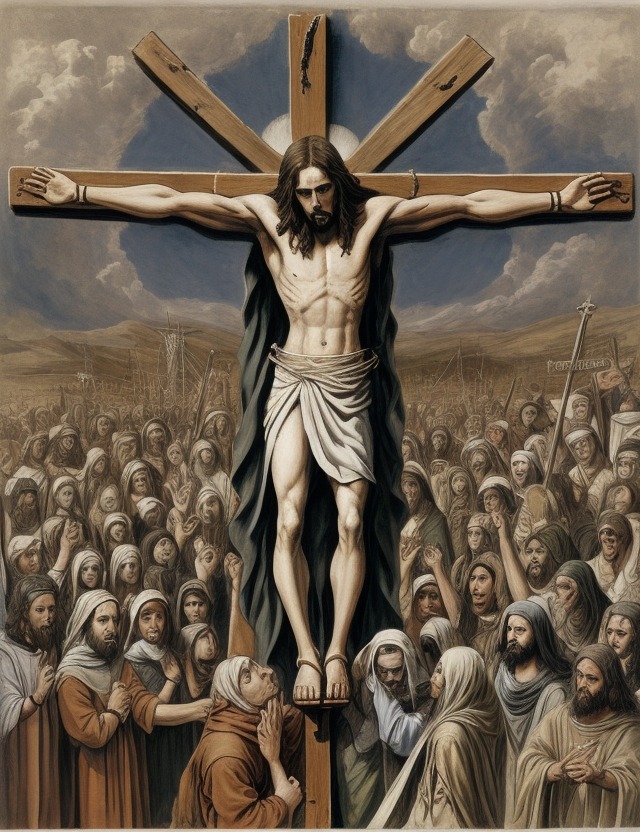A moment frozen in time, buried deep within the annals of history, the crucifixion of Jesus Christ continues to captivate minds and hearts around the world. As we delve into the gripping narrative of this cornerstone event, we embark on an inspiring journey that intertwines faith, sacrifice, and humanity’s insatiable quest for salvation. In this awe-inspiring article, we will uncover the untold details and explore the profound significance nestled within the remarkable biblical story of Jesus’ crucifixion.
Unravel the timeless tale, sense the transformative power, and emerge from this article with an enriched understanding, appreciating the magnitude of Jesus’ crucifixion like never before. Let us embark on this enlightening expedition together, as we unveil the profound story of Jesus’ crucifixion, inviting its profound influence to transcend the boundaries of time and space, resonating deeply within our souls.
Story Jesus Crucifixion Summary
Once upon a time, in a land called Jerusalem, there lived a kind and gentle man named Jesus. He was not an ordinary man, for he had special powers and could do amazing things. Jesus could heal the sick, make blind people see, and even bring the dead back to life!
Many people loved Jesus and followed him wherever he went, listening to his wise and wonderful teachings. He taught them about love, forgiveness, and the importance of helping others. But there were also some people who were jealous of Jesus. They did not like that he had so many followers, and they plotted to get rid of him.
One day, Jesus and his disciples celebrated the Passover, a special feast in Jerusalem. They gathered in a room and shared a meal together. During the meal, Jesus took some bread and said, “Take this, and eat it. It is my body.” Then he took a cup of wine and said, “Drink this. This is my blood, which will be shed for you.”
Little did Jesus know that one of his own disciples, Judas, had betrayed him. Judas had made a deal with the jealous leaders, and he agreed to show them where Jesus was so they could arrest him. After the meal, Jesus and his disciples went to a garden called Gethsemane to pray.
While they were praying, soldiers came with Judas, who betrayed Jesus with a kiss. The soldiers arrested Jesus and took him away to the high priest’s house. There, the high priest and the other leaders asked Jesus many questions, trying to find a reason to punish him.
But Jesus remained calm and kind, even when they mocked him and insulted him. They accused him of many things, but he stayed silent. Finally, they asked him, “Are you the Son of God?” Jesus replied, “I am.”
The leaders were furious and accused him of blasphemy. They decided to take Jesus to the Roman governor, Pontius Pilate, because only he had the power to sentence someone to death. Pilate asked the people if they wanted him to release Jesus, for it was a tradition to release a prisoner during the Passover feast.
But the crowd was persuaded by the leaders, who shouted, “Crucify him! Crucify him!” Pilate washed his hands, saying he was innocent of Jesus’ blood, and then he gave the order to crucify him.
Jesus was led through the streets of Jerusalem, carrying a heavy wooden cross on his back. It was a long and painful journey, but Jesus did not complain. He knew he had to carry the cross and fulfill his destiny.
Finally, they reached a hill called Golgotha, which means “Place of the Skull.” This is where they would crucify Jesus. Soldiers nailed him to the cross, and he hung there, suffering in great pain. But even in his agony, Jesus showed compassion and forgiveness. He prayed, “Father, forgive them, for they do not know what they are doing.”
As Jesus hung on the cross, his disciples and some of his followers watched in sadness. They felt hopeless, thinking that all was lost. But little did they know that something extraordinary was about to happen.
Darkness fell upon the land, and an earthquake shook the ground. The temple curtains tore in two, and the earth trembled. In that moment, Jesus cried out, “It is finished!” He took his last breath and died.
The people were filled with sorrow, but their grief would soon turn to joy. For on the third day after his death, something miraculous occurred. Jesus rose from the dead! He appeared to his disciples, showing them that he had conquered death and fulfilled his mission.
Jesus’ crucifixion and resurrection became the greatest story ever told. It taught people about love, sacrifice, and the power of forgiveness. Jesus showed that even in the darkest of times, there is always hope. And because of his sacrifice, we can have eternal life.
So, children, remember this story of Jesus’ crucifixion and resurrection. It is a story of love and redemption, reminding us that no matter how difficult life may seem, there is always hope. May we cherish the memory of Jesus’ sacrifice and strive to follow in his footsteps, spreading love, kindness, and forgiveness wherever we go.
Jesus Crucifixion Place
According to the Bible, Jesus was crucified at a place called Golgotha. Golgotha is a skull-shaped hill located just outside the northern wall of Jerusalem. It is also known as Calvary. The exact location of Golgotha is disputed, but it is believed to be the site where Jesus was crucified.
Bible Verse about Jesus Crucifixion Passage
Here are some Bible verses that describe the crucifixion of Jesus Christ:
- Matthew 27:32-56: This passage describes how Jesus was taken to Golgotha, where he was crucified along with two other criminals. It also includes the story of how Jesus predicted his betrayal by one of the disciples.
- John 19:17-30: This passage describes how Jesus carried his own cross to Golgotha, where he was crucified along with two others. It also includes the story of how Jesus spoke to his mother and the disciple whom he loved before he died.
- 1 Corinthians 1:18-25: This passage describes how the message of the cross is foolishness to those who are perishing, but to those who are being saved it is the power of God.
The Story of Jesus Crucifixion: Key Themes
The Story of Jesus’ Crucifixion is a profound and significant narrative in the Bible, depicting the final days of Jesus Christ’s life, his crucifixion, and subsequent resurrection. This narrative highlights three key themes that are crucial to understanding its deeper message.
1. Sacrifice and Redemption:
The central theme of the crucifixion story is the sacrifice of Jesus Christ for the redemption of humanity. Jesus willingly accepts his fate, knowing that his death will serve as a sacrifice to save humanity from their sins. This act of selflessness and unconditional love demonstrates the depth of God’s mercy and the hope for salvation. Through his crucifixion, Jesus offers a path of redemption for all believers, emphasizing the importance of faith and the acceptance of God’s forgiveness.
2. Suffering and Atonement:
The crucifixion story emphasizes the intense suffering that Jesus endured during his crucifixion. From his betrayal by Judas to the physical pain inflicted upon him during the crucifixion itself, Jesus experiences excruciating agony. This suffering symbolizes the weight of humanity’s sins, and Jesus’ crucifixion is seen as an act of atonement to cleanse humanity and provide them with a fresh start. The story highlights the concept that through suffering, one can find spiritual growth and transformation, connecting human suffering with the suffering of Jesus.
3. Resurrection and Hope:
The story of Jesus’ crucifixion does not end in despair but rather offers a message of hope through his resurrection. After Jesus is crucified and placed in a tomb, he rises from the dead on the third day, conquering death itself. This resurrection symbolizes the victory over evil and the promise of eternal life. It signifies the power of God’s love and the assurance that death is not the end, giving believers hope in the face of adversity, pain, and even death.
In conclusion, the crucifixion story encompasses significant themes of sacrifice and redemption, suffering and atonement, and resurrection and hope. It serves as a testament to the depths of God’s love for humanity and offers profound spiritual lessons and guidance for believers.
The Story of Jesus Crucifixion: Characters
1. Jesus: The central character of the book, Jesus is portrayed as a compassionate and wise leader. He is often described as having a peaceful aura, with kind, mesmerizing eyes that can put anyone at ease. Jesus possesses the ability to perform miracles, such as healing the sick and turning water into wine. His teachings of love, forgiveness, and righteousness make him a beloved figure among his followers, despite facing opposition from religious leaders. Jesus’ journey culminates in his crucifixion, where his unwavering faith and sacrifice inspire countless generations.
2. Mary Magdalene: A loyal and devoted follower of Jesus, Mary Magdalene is described as having a stunning beauty, with long, flowing hair that is often likened to golden threads. She possesses both strength and gentleness, using her intelligence and compassion to support Jesus’ mission. Mary Magdalene is one of the few individuals who witnesses Jesus’ crucifixion firsthand and continues to carry his message, becoming a prominent figure in spreading Christianity.
3. Pontius Pilate: As a Roman governor, Pontius Pilate is depicted as being stern and authoritative. He wears a toga, which highlights his position of power, and has a deeply furrowed brow that makes him look perpetually worried. Pilate is torn between his duty to maintain order and his reservations about condemning Jesus to death. His internal struggle and ultimate decision to wash his hands of the situation solidify him as a complex character.
4. Judas Iscariot: While Judas is often depicted as a traitor, this book delves deeper into his motivations. He is described as having a striking appearance, with piercing green eyes that evoke a sense of mystery. Judas is tormented by personal demons and, driven by desperation, agrees to betray Jesus for thirty pieces of silver. This portrayal serves as a reminder of the complexities of human nature, and the detrimental impact that guilt and regret can have on a person.
5. Simon of Cyrene: Simon plays a small but significant role in the story, as he is compelled to carry Jesus’ cross when he is physically weak from the scourging. He is described as a burly man, with a playful sense of humor and warm smile that belies his physical strength. Simon’s experience carrying the cross offers a lesson in compassion and selflessness, as he temporarily bears Jesus’ burden.
6. Mary, Mother of Jesus: Mary, the mother of Jesus, is depicted as a woman of seemingly ageless beauty and grace. Her composure and unwavering faith make her a pillar of strength throughout the story. She has a nurturing nature, offering solace to all who come to her in times of need. Mary’s heart-wrenching journey as a witness to her son’s crucifixion showcases the indomitable spirit of a mother’s love.
7. The Centurion: The centurion, a Roman soldier assigned to oversee Jesus’ crucifixion, initially embodies the hardness and brutality of his occupation. However, as he witnesses Jesus’ conduct during his crucifixion and death, he undergoes a transformation. The centurion is described as having a strong and imposing figure, yet his hardened exterior slowly softens as he acknowledges Jesus’ divinity, exclaiming, “Truly, this man was the Son of God!”
8. The Thieves: Two thieves are crucified alongside Jesus, and they provide a stark contrast in character. One thief initially mocks Jesus, while the other shows remorse and asks for forgiveness. The humorous twist lies in their contrasting criminal records, with one thief having stolen bread to feed his family, while the other thief has a comically long list of thefts, ranging from mundane items to more ludicrous choices, adding an unexpected touch of levity amidst the sorrowful scene.
This book showcases an array of multifaceted characters, each contributing to the profound narrative of Jesus’ crucifixion. Their diverse personalities, physical descriptions, and quirky details capture the essence of their roles and emphasize the emotional impact of the story.
The Story of Jesus Crucifixion: Symbols
1. The Cross: The most significant symbol in the book of The Story of Jesus Crucifixion is the cross. It represents the central event and theme of the entire narrative – the crucifixion of Jesus. It served as the means of execution for criminals during Roman times, but in this context, it becomes a powerful symbol of love, sacrifice, and redemption. The cross represents Jesus willingly laying down his life for the sins of humanity, demonstrating the depths of his love and the ultimate act of selflessness.
2. The Crown of Thorns: Another significant symbol in the book is the crown of thorns that was mockingly placed on Jesus’ head by the Roman soldiers. This crown not only represents the physical pain and humiliation Jesus endured but also carries deeper symbolic meaning. Thorns are often associated with the consequences of sin, as it was after the Fall that thorns and thistles were said to grow from the ground. By wearing the crown of thorns, Jesus takes upon himself the shame and sufferings caused by human sin, illustrating his role as the Lamb of God who takes away the sins of the world.
3. The Veil of the Temple: The tearing of the veil in the temple is another significant symbol in the book. After Jesus breathes his last on the cross, the veil that separated the Holy of Holies in the temple, the innermost sanctuary, from the outer precincts is torn from top to bottom. This tearing signifies the opening of direct access to God for all believers through Jesus’ sacrifice. It represents the end of the Old Covenant and the beginning of the New Covenant, where believers no longer need priests as intermediaries but can have a personal relationship with God through Jesus Christ. The tearing of the veil symbolizes the invitation to all to come boldly and approach God’s presence.
The Story of Jesus Crucifixion: Culture Impact
The Story of Jesus Crucifixion is a profound literary work that has left an indelible mark on the world’s cultural landscape. Published over two millennia ago, this book has endured the test of time and continues to captivate readers of all ages.
Historically, the impact of The Story of Jesus Crucifixion is immeasurable. It is widely regarded as one of the most influential narratives that shaped the course of Western civilization. The book not only presented a detailed account of the crucifixion of Jesus Christ, but it also explored profound theological and philosophical themes, igniting contemplation and debate among scholars, theologians, and ordinary individuals alike.
Perhaps one of the most remarkable achievements of The Story of Jesus Crucifixion is its ability to transcend epochs and boundaries, reaching audiences across diverse cultures and languages. The book’s narrative power and its universal message – one of love, redemption, and sacrifice – have resonated with countless generations. It has become a cornerstone of Christian teachings, inspiring faith and guiding moral compasses around the globe.
With time, The Story of Jesus Crucifixion has also spawned various artistic manifestations. Paintings, sculptures, music, and theater productions have been influenced by this book, depicting the crucifixion scene with unparalleled richness and emotion. The image of Jesus on the cross has become an iconic symbol of Christian faith, fostering a sense of solidarity and devotion among believers worldwide.
Despite its deeply solemn subject matter, The Story of Jesus Crucifixion has also generated moments of lightheartedness and amusement. Countless jokes and anecdotes have emerged over the centuries, often centered around the seemingly paradoxical aspects of the narrative. From humorous references to Jesus turning water into wine during the crucifixion to clever wordplay related to the resurrection, these instances of humor serve as a testament to the book’s enduring popularity and its ability to engage people on both profound and lighter levels.
In summary, The Story of Jesus Crucifixion has had a profound and lasting impact on the world’s culture. Through its historic significance, timeless message of love and sacrifice, artistic influence, and moments of humor, this book has secured its place as a seminal work in shaping the fabric of human society. It continues to inspire and captivate individuals from all walks of life, fostering contemplation, devotion, and a shared cultural understanding.
FAQs
1. What is “The Story of Jesus’ Crucifixion” book about?
The Story of Jesus’ Crucifixion is a book that recounts the events leading up to and including Jesus Christ’s crucifixion, as described in the Bible. It delves into the historical and biblical context, exploring the significance of Jesus’ sacrifice and its impact on Christianity.
2. Why is Jesus’ crucifixion considered significant?
Jesus’ crucifixion is considered significant because, according to Christian beliefs, it represents the ultimate sacrifice made for humanity’s sins. It is seen as the climax of God’s plan for salvation, offering redemption and eternal life to those who have faith in Jesus’ death and resurrection.
3. Is “The Story of Jesus’ Crucifixion” a religious book?
Yes, “The Story of Jesus’ Crucifixion” is a religious book that focuses on one of the central events in Christian theology. It explores the passion narrative as depicted in the Bible and its theological implications, making it particularly relevant for those interested in Christian teachings.
4. Can non-Christians benefit from reading this book?
While “The Story of Jesus’ Crucifixion” holds particular significance for Christians, non-Christians can also benefit from reading it. It provides valuable historical and cultural insights into Jesus’ life and the events surrounding his crucifixion. Additionally, it can serve as an introduction to Christian beliefs and practices.
5. Is “The Story of Jesus’ Crucifixion” suitable for all age groups?
The content of “The Story of Jesus’ Crucifixion” is generally meant for a mature audience due to the portrayal of graphic violence and religious themes. Parents and guardians should exercise discretion when considering whether it is appropriate for younger readers. However, there are also age-appropriate adaptations and retellings available for children.










